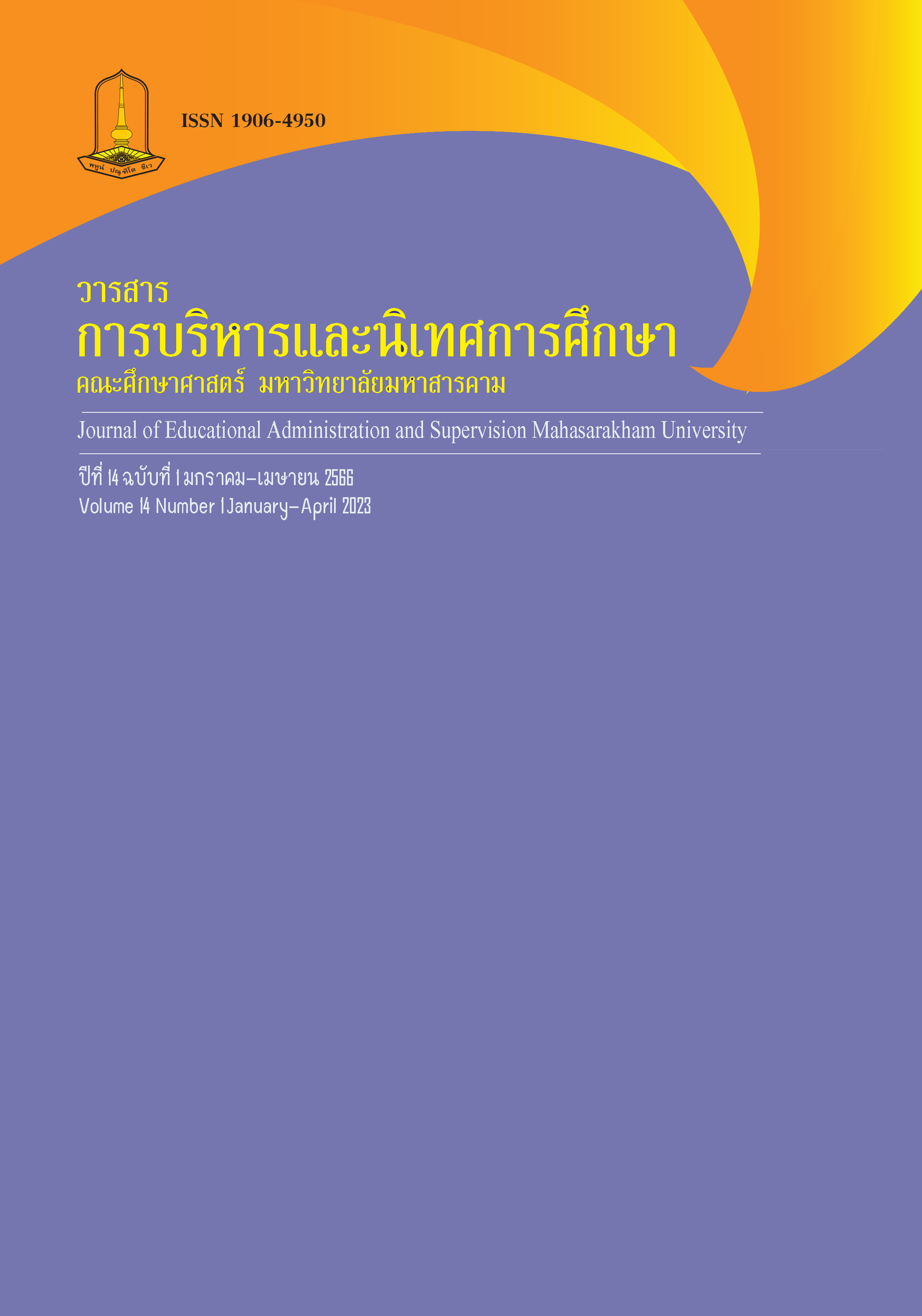Developing a Program to Strengthen Collective Leadership of School Administrator under the Secondary Educational Service Area Office Mahasarakham
Main Article Content
Abstract
This research aimed: 1) to explore existing situation, desirable situation, and needs to develop the collective leadership of school administrators under the secondary educational service area office Mahasarakham; and 2) to develop the program to strengthen collective leadership of school administrators under the secondary educational service area office Mahasarakham. Mixed methods research was employed. The research divided into two phases: The 1st phase was exploring the existing situations, desirable situations, and needs to develop the collective leadership of school administrators. Data were collected from 316 samples, consisting of secondary school administrators and teachers under the secondary educational service area office Mahasarakham through stratified random sampling technique; and the 2nd phase was developing a program to strengthen collective leadership of school administrators. The program was evaluated to find propriety and feasibility by 5 experts. The research instruments were existing and desirable situations questionnaire, interview form, and the program evaluation form. Statistics used in analyzing data were mean, standard deviation, and modified priority needs index.
The research results were as follows:
1. The existing situation of collective leadership of school administrators was at a high level, and the desirable situation was at the highest level. The needs to develop collective leadership of school administrators from high to low were make the change, share vision, wholeness, build a strong team, and develop the individual respectively.
2. The program to strengthen collective leadership of school administrators under the secondary educational service area office Mahasarakham consisted of 5 parts: 1) Rationale; 2) Objectives; 3) Content consists of 5 modules; 4) methods and development activities comprising three steps, Step 1 develop awareness, Step 2 develop knowledge, Step 3 develop through on the job learning; and 5) assessment.
Downloads
Article Details
References
กันตธี เนื่องศรี. (2563). การพัฒนาโปรแกรมเสริมสร้างภาวะผู้นำพลังร่วมของผู้บริหารโรงเรียนประถมศึกษา สังกัดสำนักงานคณะกรรมการการศึกษาขั้นพื้นฐาน. [วิทยานิพนธ์ปริญญาการศึกษาดุษฎีบัณฑิต , มหาวิทยาลัยมหาสารคาม]. ฐานข้อมูลงานวิจัย (ThaiLis).
ชลนภา อนุกุล. (2557, 18 กรกฎาคม). ผู้นำร่วม ผู้นำแห่งอนาคต. จิตวิวัฒน์. http://jitwiwat.blogspot.com/2014/07/blog-post_18.html
ฐิติกาญจน์ อัตศรกุล. (2564). หลากสี ต่างเลนส์ ว่าด้วยแนวคิดทฤษฎีนำร่วมเคลื่อนสังคม. นครปฐม: โครงการผู้นำแห่งอนาคต คณะวิทยาการเรียนรู้และศึกษาศาสตร์ มหาวิทยาลัยธรรมศาสตร์.
ธนัญธร เปรมใจชื่น. (2561, 29 มีนาคม). ประมวลการเรียนรู้: เวทีบ่มเพาะภาวการณ์นำร่วมสำหรับพลเมืองรุ่นใหม่. ผู้นำแห่งอนาคต : Leadership for the Future. https://www.leadershipforfuture.com/ประมวลการเรียนรู้จาก-เว.html
บัณฑิต ลักษณะภาวรรณ. (2562). ภาวะผู้นำพลังร่วมที่ส่งผลต่อประสิทธิผลการปฏิบัติงานของครูในโรงเรียนสังกัดสำนักงานเขตพื้นที่การศึกษามัธยมศึกษา เขต 25. [วิทยานิพนธ์ปริญญาการศึกษามหาบัณฑิต, มหาวิทยาลัยขอนแก่น]. ThaiLIS.
ประเวศ วะสี. (2559). ระบบการสร้างผู้นำสำหรับประเทศไทยยุคใหม่ (พิมพ์ครั้งที่ 2). นครปฐม: ศูนย์จิตตปัญญาศึกษา มหาวิทยาลัยมหิดล.
มิชิตา จำปาเทศ รอดสุทธิ. (2549, 21 กันยายน). Collective Leadership. SoftBankThai. https://www.softbankthai.com/Article/Detail/843/Collective-Leadership.html
สำนักงานเขตพื้นที่การศึกษามัธยมศึกษามหาสารคาม. (2565). แผนพัฒนาคุณภาพการศึกษาขั้นพื้นฐาน พ.ศ. 2565-2569 สำนักงานเขตพื้นที่การศึกษามัธยมศึกษามหาสารคาม. สำนักงานเขตพื้นที่การศึกษามัธยมศึกษามหาสารคาม.
สำนักงานคณะกรรมการการศึกษาขั้นพื้นฐาน. (2556). นโยบายสำนักงานคณะกรรมการการศึกษาขั้นพื้นฐาน ปีงบประมาณ พ.ศ. 2557. สำนักงานคณะกรรมการการศึกษาขั้นพื้นฐาน.
สุภัคฉวี เอี่ยมสำอาง. (2558). การศึกษาภาวะผู้นำร่วมของหัวหน้างานในสถานศึกษา สังกัดสำนักงานเขตพื้นที่การศึกษามัธยมศึกษา เขต 39. [วิทยานิพนธ์ปริญญาครุศาสตรดุษฎีบัณฑิต, จุฬาลงกรณ์มหาวิทยาลัย]. ThaiLIS.
สุวิมล ว่องวาณิช. (2558). การวิจัยประเมินความต้องการจำเป็น. กรุงเทพฯ: สำนักพิมพ์แห่งจุฬาลงกรณ์มหาวิทยาลัย.
ไอยเรศ บุญฤทธิ์. (2564). ทวิวัจน์การวิจัย เรื่องเล่าจากนักวิทยาการเรียนรู้สู่กระบวนทัศน์การทำงานในชุมชน. นครปฐม: โครงการผู้นำแห่งอนาคต คณะวิทยาการเรียนรู้และศึกษาศาสตร์ มหาวิทยาลัยธรรมศาสตร์.
Alsaedi, F. (2022). The important role of collective leadership in the face of change: Literature review. Open journal of leadership, 11(1), 1-12.
Fox, E. M., & Urwick, L. F. (1977). Dynamic administration: The collected papers of Mary Parker Follett. Hippocrene Books.
Greenleaf, R. K. (2002). Servant leadership: A journey into the nature of legitimate power and greatness. Paulist Press.
Health and Social Care. (2017). HSC Collective leadership strategy: Health and wellbeing 2026: Delivering together. Department of Health. Northern Ireland.
Kellogg Foundation. (2007). The collective leadership framework: A workbook for cultivating and sustaining community change. Takoma Park.
Krejcie, R. V., & Morgan, D. W. (1970). Determining sample size for research activities. Educational and psychological measurement, 30(3), 607-610.
Kuenkel, P., Kühn, E., Stucker, D., & Williamson, D. F. (2021). Leading transformative change collectively. Routledge.
O'Neill, C., & Brinkerhoff, M. (2017). Five elements of collective leadership for early childhood professionals. Redleaf Press.
Trafford, D., & Boggis, P. (2017). Beyond default: Setting your organization on a trajectory to an improved future. LID Publishing.
West, M. A., Eckert, R., Steward, K., & Pasmore, W. A. (2014). Developing collective leadership for health care (Vol. 36). King's Fund London.


